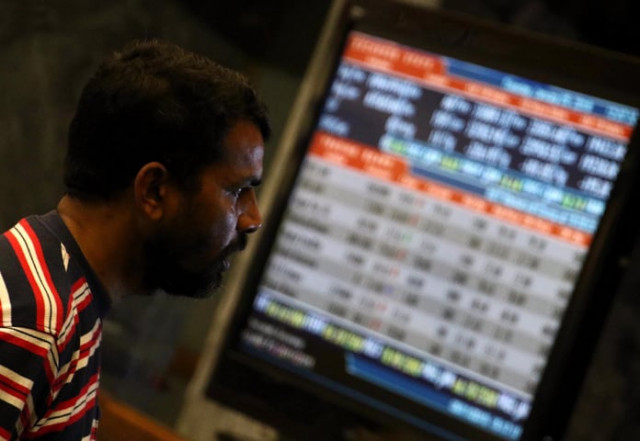Business
PSX surges past 150,000 as bulls dominate trading – SUCH TV

The Pakistan Stock Exchange (PSX) continued its upward momentum on Tuesday, with the benchmark KSE-100 Index crossing the 150,000-point mark, reflecting renewed investor confidence despite ongoing flood warnings in Sindh.
During intraday trading, the KSE-100 Index surged by 738.87 points, or 0.49%, to close at 150,709.99 points.
Out of 434 companies traded, 262 saw their share prices rise, 153 declined, and 19 remained unchanged.
Investor sentiment was further boosted after Finance Minister’s Advisor Khurram Shehzad announced the early retirement of Rs2,600 billion in debt including Rs1.6 trillion owed to the State Bank of Pakistan within just 59 days, a historic move enhancing fiscal credibility.
The market also reacted positively to Pakistan’s Consumer Price Index (CPI) for August, which fell to 3% from 4.1% in July, well below analysts’ expectations.
This unexpected data spurred buying across multiple sectors.
On Monday, the KSE-100 had also posted gains of 1,353.34 points (0.91%), closing at 149,971.12 points.
A total of 1.18 billion shares were traded on Tuesday, compared to 1.34 billion on Monday, with the total turnover at Rs48.849 billion versus Rs52.305 billion previously.
The top three trading companies were B.O. Punjab with 97,697,793 shares at Rs16.58 per share.
K-Electric Limited with 85,903,125 shares at Rs5.43 per share, and Pervez Ahmed Co. with 54,520,834 shares at Rs3.04 per share.
PAI Holding Company LimitedB witnessed a maximum increase of Rs 301.00 per share price, closing at Rs 27,300.00, whereas the runner-up was Hoechst Pakistan Limited with Rs216.81 rise in its per share price to Rs4,026.63.
Unilever Pakistan Foods Limited witnessed a maximum decrease of Rs 920.32 per share closing at Rs 32,701.00 followed by Nestle Pakistan Limited with Rs 77.20 decline in its share price to close at Rs 8,439.18.
Business
Asian stocks today: Markets trade mostly in red on last trading day of 2025; HSI sheds over 200 points, Kospi flat – The Times of India

Asian markets slipped mostly into red on Wednesday, the final trading session of 2025, as investors remained cautious ahead of the New Year holiday and took cues from Wall Street losses.In Hong Kong, HSI slipped over 224 points to 25,630. Nikkai was also trading at a loss, shedding 187 points or 0.3%. Shanghai and Shenzhen were also down 0.07% and 0.67% at 10:35 AM IST. South Korea’s Kospi was also down 6 points to trade at 4,214. With the holiday season keeping participation low, trading volumes across the region remained thin. Commodities offered a steadier picture, with precious metals holding their ground after retreating from record levels seen earlier in the week. The uneven performance followed a muted session in the United States, where major Wall Street indices finished slightly lower on Tuesday. Investor unease over stretched valuations in artificial intelligence (AI)-linked stocks continued to weigh on sentiment. Even so, US markets were still set to deliver solid gains for the full year, a trend mirrored across much of Asia. Regional markets benefited from a combination of easing monetary conditions and a powerful rally in technology shares. In China, fresh official data showed factory activity edged up marginally in December, offering a rare positive signal at the close of an otherwise subdued year for the world’s second-largest economy. A key driver of the year’s global market strength has been the US Federal Reserve’s shift towards monetary easing in the latter half of 2025, alongside a flood of investment into AI-related technologies. Minutes from the Fed’s December policy meeting revealed that most officials consider further interest rate cuts appropriate, provided inflation continues to cool as anticipated. Precious metals have been among the most volatile assets in recent days, lifted by their demand as safe-haven investments amid ongoing geopolitical tensions. Gold and silver both touched record highs last week before pulling back.
Business
Bank holiday on New Year: Will banks remain closed on December 31, 2025 & January 1, 2026? Check state-wise list – The Times of India

As 2025 comes to an end and the new year is almost here, customers across India are looking for clarity on whether banks will be open on December 31 and January 1. While banks in some states will remain closed on December 31, 2025, others will continue normal operations on New Year’s Eve and the New Year. Being aware of bank holidays can help customers plan essential financial transactions in advance, avoid last-minute delays and ensure uninterrupted access to services that require branch visits.
In which states banks will remain closed on December 31, 2025?
Banks in these two states will remain closed on the new year’s eve on December 31, 2025, in observance of New Year’s Eve and Imoinu Iratpa.
Where will banks remain close on January 1, 2026?
- Mizoram
- Tamil Nadu
- Sikkim
- Manipur
- Arunachal Pradesh
- Nagaland
- West Bengal
- Meghalaya
Banks in these states will remain closed on January 1, 2026, on the occassion of New Year’s Day and Gaan-Ngai. However, bank closure does not means that customers can not process their financial transactions during holidays. Users can continue to access online banking services, ATMs, mobile banking apps and UPI for fund transfers, bill payments and other routine transactions. Meanwhile, in-person banking services such as large cash deposits, cheque clearances and issuance of demand drafts will not be available on these days. Account holders are advised to plan their banking needs in advance to avoid inconvenience during the festive period and make full use of digital banking platforms for uninterrupted services.It is important to note that bank holidays vary by state. According to the RBI, banks also remain closed on every second and fourth Saturday of the months.
Business
Chinese imports: India imposes 12% tariff on steel inflows; aims to curb cheap shipments with safeguards – The Times of India

India rolled out a new trade measure on Tuesday, imposing safeguard duties on certain steel imports for a period of three years. The move comes as a push to protect domestic manufacturers from a surge in low-cost overseas supplies, particularly from China.As per a finance ministry notification, the safeguard duty will stand at 12% in the first year, ease to 11.5% in the second, and fall further to 11% in the final year. The decision follows a detailed probe into import trends and their impact on local producers.The levy will apply to steel shipments from countries including China, Vietnam and Nepal. However, imports from some developing nations have been kept outside the scope of the measure. The order also makes it clear that specialty steel products, such as stainless steel, will not be covered under the safeguard duty.The directorate general of trade remedies, which examined the matter, recommended the three-year tariff after observing a “recent, sudden, sharp and significant increase in imports … causing and threatening to cause serious injury to the domestic industry,” the order stated. The latest move builds on an earlier step taken in April, when the government imposed a temporary 200-day safeguard duty of 12% on similar steel products, according to a Reuters report.Officials from the federal steel ministry have repeatedly stated that unchecked inflows of cheap and sub-standard steel could harm India’s domestic steel sector, prompting the need for protective measures.The decision also comes against the backdrop of growing global trade tensions in the steel market. US President Donald Trump’s import tariffs on steel have intensified scrutiny of Chinese exports, leading countries such as South Korea and Vietnam to introduce anti-dumping duties earlier this year.
-

 Sports4 days ago
Sports4 days agoBrooks Koepka should face penalty if he rejoins PGA Tour, golf pundit says
-

 Business4 days ago
Business4 days agoGovt registers 144olive startups | The Express Tribune
-

 Politics1 week ago
Politics1 week ago2025 marks decisive reset in Pakistan-US ties: Washington Times
-

 Politics4 days ago
Politics4 days agoThailand, Cambodia agree to ‘immediate’ ceasefire: joint statement
-

 Politics1 week ago
Politics1 week agoMoscow car blast kills Russian general hours after US talks
-

 Business1 week ago
Business1 week agoNeptune Logitek Shares List At 26% Discount, IPO Investors Suffer Nearly Rs 30,000 Losses
-

 Entertainment1 week ago
Entertainment1 week agoTimothée Chalamet in question for ‘Marty Supreme’ press tour attitude
-

 Fashion1 week ago
Fashion1 week agoNew Balance Americas SVP Melissa Worth departs











